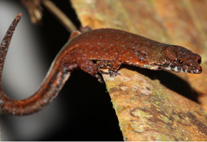Abstract
Based on morphological and molecular data, we describe three new species of the genus Lepidoblepharis with granular dorsals from Panama (Lepidoblepharis emberawoundule sp. nov., Lepidoblepharis rufigularis sp. nov., and Lepidoblepharis victormartinezi sp. nov.). The results of our molecular analyses confirm the existence of five deeply differentiated genealogical lineages among Panamanian Lepidoblepharis. We present detailed descriptions of their morphology, including some new valuable scalation characters (ventral and subfemoral escutcheon) and hemipenes, as well as comparisons with the other two species of the genus known to occur in Panama (L. sanctaemartae and L. xanthostigma) and their South American congeners. Last, we provide an updated identification key for the genus Lepidoblepharis in Central America.

